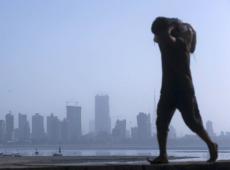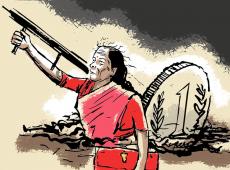India's Consumption Growth Slows Amid High Inflation - India Ratings & Research
By Rediff Money Desk, NEWDELHI Jan 07, 2024 11:05
India's economy faces a challenge of lower consumption growth due to high inflation impacting lower income brackets, says India Ratings & Research. Bringing down inflation is key to boosting disposable income and driving sustainable growth.

Illustration: Dominic Xavier/Rediff.com
New Delhi, Jan 7 (PTI) The Indian economy is facing the challenge of lower consumption growth as high inflation is impacting people in the lower income bracket, India Ratings and Research Chief Economist Devendra Kumar Pant said on Sunday.
He said although the country's economy is now resilient enough to deal with the dual shocks of below-normal monsoon and high global oil prices, the challenge is to bring down inflation so that people can have more disposable income in their hands.
"One percentage point reduction in inflation will lead to 64 basis points increase in GDP or 1.12 percentage points increase in PFCE (Private final consumption expenditure) growth... If inflation can be brought down by 1 percentage point, it would be a win win," Pant said in an interview to PTI.
PFCE denotes money spent by individuals on goods and services for personal consumption.
As per the estimates of Ind-Ra, which is a subsidiary of global rating agency Fitch Ratings, PFCE would grow 5.2 per cent year on year in current fiscal, as against 7.5 per cent in last fiscal.
Pant said economic growth is being driven by government expenditure and such high level of capex year after year poses risks to fiscal deficit and debt, which in turn will keep interest rates elevated.
"Until private corporate investment starts and government withdraws some of the investment they are doing, the economy will not have a stable growth path," Pant said.
The Indian economy grew 7.2 per cent in 2022-23 fiscal and as per government estimates, the growth in the current fiscal would be 7.3 per cent.
Pant said there are two kinds of India in terms of income bracket -- one is people from upper income and the other those in the lower income bracket. The wages of people at the bottom end of pyramid are not growing at the same pace as the people in organised sector or people in upper end.
"We have done a study and found that people at the bottom 50 per cent bracket face a higher inflation compared to people in the top 50 per cent of population. Prices of the good and services consumed mainly by the people in the bottom of the pyramid is growing faster than what is consumed by upper end of the pyramid," he said.
Retail or consumer price index based inflation rose to a 3-month high of 5.55 per cent in November, mainly due to rise in food prices.
He said although the country's economy is now resilient enough to deal with the dual shocks of below-normal monsoon and high global oil prices, the challenge is to bring down inflation so that people can have more disposable income in their hands.
"One percentage point reduction in inflation will lead to 64 basis points increase in GDP or 1.12 percentage points increase in PFCE (Private final consumption expenditure) growth... If inflation can be brought down by 1 percentage point, it would be a win win," Pant said in an interview to PTI.
PFCE denotes money spent by individuals on goods and services for personal consumption.
As per the estimates of Ind-Ra, which is a subsidiary of global rating agency Fitch Ratings, PFCE would grow 5.2 per cent year on year in current fiscal, as against 7.5 per cent in last fiscal.
Pant said economic growth is being driven by government expenditure and such high level of capex year after year poses risks to fiscal deficit and debt, which in turn will keep interest rates elevated.
"Until private corporate investment starts and government withdraws some of the investment they are doing, the economy will not have a stable growth path," Pant said.
The Indian economy grew 7.2 per cent in 2022-23 fiscal and as per government estimates, the growth in the current fiscal would be 7.3 per cent.
Pant said there are two kinds of India in terms of income bracket -- one is people from upper income and the other those in the lower income bracket. The wages of people at the bottom end of pyramid are not growing at the same pace as the people in organised sector or people in upper end.
"We have done a study and found that people at the bottom 50 per cent bracket face a higher inflation compared to people in the top 50 per cent of population. Prices of the good and services consumed mainly by the people in the bottom of the pyramid is growing faster than what is consumed by upper end of the pyramid," he said.
Retail or consumer price index based inflation rose to a 3-month high of 5.55 per cent in November, mainly due to rise in food prices.
Read More On:
DISCLAIMER - This article is from a syndicated feed. The original source is responsible for accuracy, views & content ownership. Views expressed may not reflect those of rediff.com India Limited.
You May Like To Read
TODAY'S MOST TRADED COMPANIES
- Company Name
- Price
- Volume
- GTL Infrastructure
- 2.93 ( -4.87)
- 226206286
- IFL Enterprises
- 1.30 (+ 4.84)
- 81461564
- Vodafone Idea L
- 16.79 (+ 0.66)
- 67447398
- NCL Research
- 0.95 ( -4.04)
- 31996628
- Franklin Industries
- 3.73 (+ 3.32)
- 21511209
MORE NEWS

Navi Mumbai Airport ILS Signal Testing Begins
The Airports Authority of India (AAI) has begun ILS signal testing at the...

Air India VRS for Non-Flying Staff Ahead of...
Air India has announced a voluntary retirement scheme (VRS) and voluntary separation...
Fisher Groups Oppose WTO Fisheries Subsidy Talks
Small-scale fisher groups from India, Indonesia, and Bangladesh demand WTO keep...












 © 2024 Rediff.com India Limited. All rights reserved.
© 2024 Rediff.com India Limited. All rights reserved.